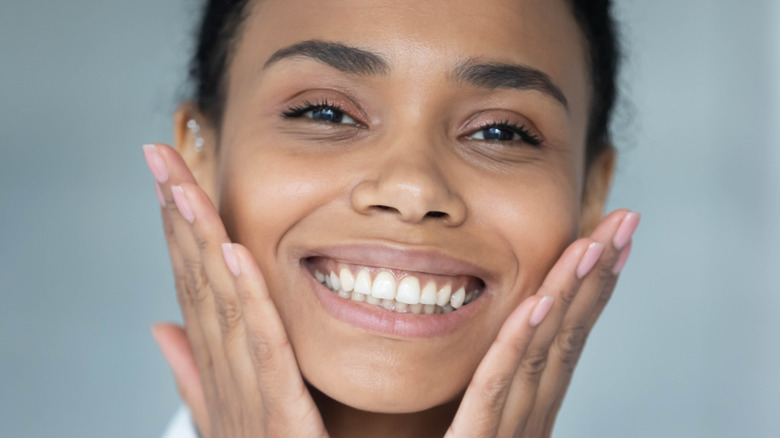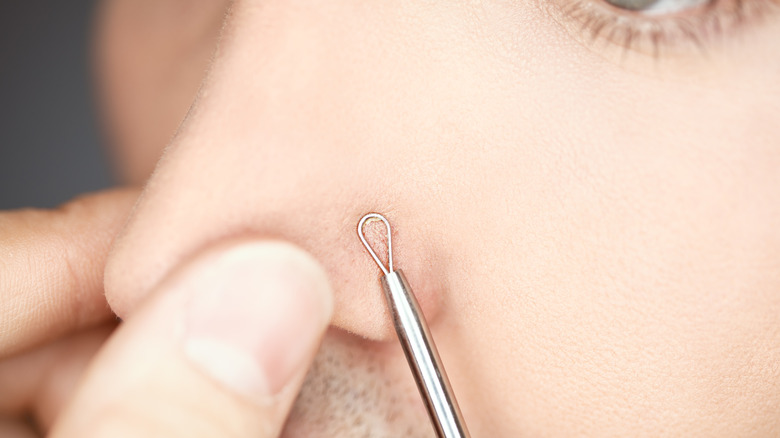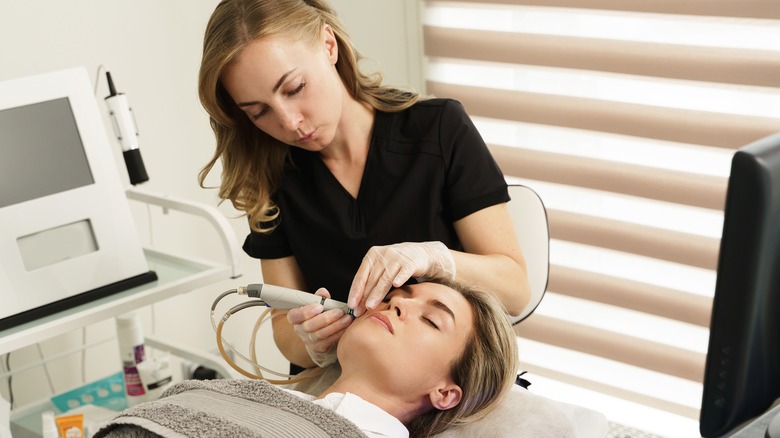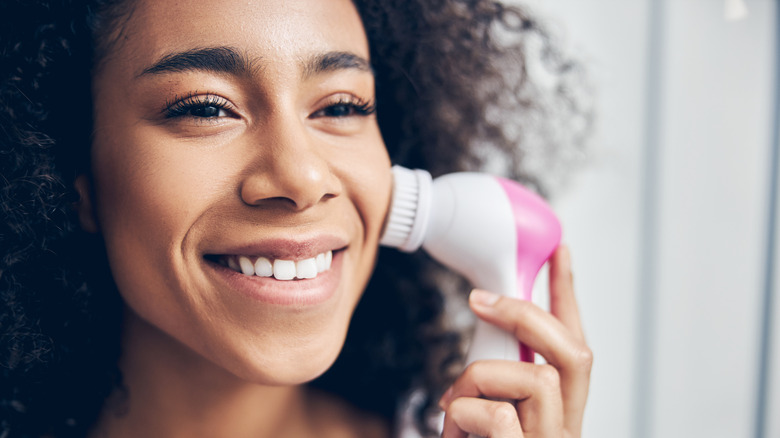Is It Safe To Use Extraction Tools At Home?
If there's one beauty faux pas that we've all fallen victim to ignoring, it's to not pick at our faces. There's simply something so disrespectful about a pimple popping up before a big event that sends you into a blind rage where you see no choice but to attempt to minimize it by squeezing it out. Fast forward to 20 minutes of trying to eradicate it later, and suddenly that tiny pimple you started out with has transformed into a red crater.
Try as dermatologists and experts might, they have yet to convince people to step aside and let their breakouts come and go in peace, as noted by Allure. While that may be a losing battle, one that we urgently must heed expert advice on is the battle of face tools. We're not talking about the innocent gua sha or even the TikTok favorite ice roller, per the Grove Collaborative, though ice cubes should be your new skincare go-to. Even hydrocolloid pimple patches have been backed by dermatologists.
But once you start to whip out an at-home extraction tool, everyone seems in agreement that you're about to do a lot more damage than good. Attempting your own at-home facial should perhaps be reserved for a simple clay mask followed by a sheet mask, but let's nevertheless dive into home extraction tool use.
How at-home extraction tools work
There's a glaring reason why getting a clarifying or deep cleansing facial done by a professional is so much better than your weekly clay face mask. The process may be excruciating at times, but extractions are a game-changer, especially for deeply clogged pores or oily skin types. After all, skincare routines for dehydrated oily skin can often use the extra help to revitalize them.
The way that extractions work is by tackling blackheads or comedones which are small bumps or dark spots that may show up on your skin as the result of a buildup of oil or skin debris, per Derm Collective. Extractions use either a simple metal double-headed tool or a more advanced suction device to get deep into your pores and extract this buildup, leaving you with smoother and clearer skin.
The results are great, which is why so many people consider trying their hand at it rather than spending extra money on a professional facial. At-home extraction tools are typically metal tools with a hook/loop edge on either side, and the idea is to harshly press that hook onto your clogged pore and force the buildup to pop out. Surely, you can imagine how harmful this process can be when done incorrectly. Pressing a sharp, fine object into your skin with pressure? Sounds like a surefire way to end up with a much worse skin environment than you went into the process with — and experts have confirmed that it is.
Why at-home extractions are dangerous
It would be great if you didn't have to keep paying for a professional facial and could DIY their work yourself, but after all, they have a ton of knowledge and experience that's worth the extra cash. Taking on skincare processes by yourself and attempting them at home has become normalized online, especially considering the slew of at-home skincare tools readily available to order overnight. Extraction tools, however, are used by professionals for a reason.
"Misuse of the device itself, using a device with a poorly designed structure, and deep rupturing of the lesion, which induces a severe inflammatory response," Dr. Carl Thornfeldt explained to Byrdie on the danger of using an extraction tool yourself. "A major difficulty is the proper alignment of the device to the skin contour and shape."
Using an extraction tool the wrong way could not only not help your blackheads, but also worsen things by resulting in scarring — and even forcing the bacteria deeper into your skin. As Dr. Morgan Rabach explained to the Sunday Edit, "Trying to extract the blackhead with a tool can cause mini tears and can push the clogged pore deeper into the skin, ultimately leading to a deeper, more inflamed pimple that can then leave scarring and pigmentation."
How to safely clear pores at home
While the news that extraction tools aren't safe to use at home might feel a little defeating to true DIY babes, there's no reason to fret. There is a safe way to clean out and minimize the appearance of your pores at home. Start by loosening blackheads with steam. You can invest in a steamer, such as the Nano Ionic Hot Mist Face Steamer on Amazon, or simply boil some water on the stove. (Here, you can add a couple of herbal tea bags for a simultaneous aromatherapy session.) Drape a clean towel over your head to trap the steam, and hold your pose for five minutes.
Once you've allowed your face to cool, it's time to exfoliate while the debris inside your pores is loosened and softened. Use a facial brush, a gentle scrub, or a chemical exfoliant containing alpha-hydroxy acids (AHAs) to clear away blackheads and unblock pores. Then, apply a toner to tighten and minimize the appearance of your newly cleaned pores, followed by your usual serums and moisturizer, and go show off your at-home masterpiece.



